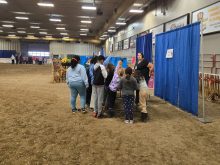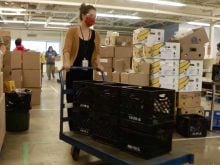Winter pressure on already strained feed supplies has some producers searching for credit, as they look to tide themselves over until spring.
Cash flow has been tight in a sector racked by drought last year — including a depressed cattle market as a glut of producers were forced to downsize herds. Cattle producers have since noted extremely tight feed supplies, both because of poor forage harvests last year, and a cold, stormy winter cutting deeper than expected into feed reserves.
Why it matters: Livestock producers have little margin for error on feed and sluggish cash flow to widen the buffer, and Manitoba’s harsh winter has pushed the bounds of that equation.
Read Also

What is perfect Christmas weather?
What is ‘perfect’ Christmas weather on the Prairies? Here’s where you should head this holiday, according to historical weather data.
Access to credit is among the potential issues noted by Manitoba Beef Producers president Tyler Fulton, as his sector stretches to source extra feed.
Those same producers may have had little chance to catch their financial breath, given the cumulative impact of several dry years in a row. In 2019, for example, producers in the Interlake were similarly hit with extra purchased feed costs, following poor forage harvests and a truncated grazing season.
AgriRecovery programs, announced last fall, do include financial aid for purchasing and transporting feed to maintain breeding herds.
However, producers must be able to make the initial purchase before they can be reimbursed under AgriRecovery, Fulton noted.
Under the receipt-based AgriRecovery program, producers must provide invoice and proof of purchase as part of their application for aid.
Invoices dated on or before April 15, 2022 are eligible if the purchase or transportation was to continue maintaining the eligible breeding animals owned on March 15, 2022.
Wilco van Meiji, district director with Farm Credit Canada (FCC) and a beef producer in western Manitoba, reported an initial wave of producers from different sectors looking for credit last fall. Demand later slowed.
“I think we’re going to see that (increase) here again right now as we’re burning through some of that revenue of cash sales and that kind of stuff and people are uncovering maybe what the shortfall might look like and what they might need as far as a bridge is concerned,” he said.
That initial wave, he said, was largely expected, given 2021 growing season conditions. The harsh winter, however, has sparked some above-expected demand recently.
Within the potential clients, he said, there was a wide spectrum in terms of both how deeply they wanted to tap into credit and how successful they were in accessing that credit.
In his view, he said, AgriRecovery programs as laid out by the province have been “exceptional” and have helped “a great deal with respect to some of the need.”
He acknowledged, however, that those programs require initial purchasing power, and the need for credit increased as producers, including those who sold into a poor cattle market, saw less gross revenue.
FCC “came out early” with options for drought-stressed producers across the ag sector, van Meiji said.
One of those options was an adverse credit line.
“So essentially, giving access to some short-term cash,” he said. “It’s still debt, at the end of the day. It’s certainly not from a grant money standpoint. But it gave access to short-term cash. For the crop producers, it was like, hey, if crop insurance is coming in with payments later on, it might bridge you to that.”
For cattle producers, he added, that option would similarly cover cash gaps before aid payments arrive.
Accessibility
Dwight Sander, assistant vice-president of business solutions with Noventis Credit Union in Ashern, says he has seen pleasantly few producers needing to dip into their credit.
“There’s been a little bit, because they used up a bit more (feed) than they expected, so there was a little bit of scrambling to find some more,” he said.
Sander credited the province’s AgriRecovery programs and other feed aid for the lack of borrowers. Many in his area have applied for feed or transportation assistance through those programs, he said, while initiatives from Eastern Canada to send hay have also been beneficial.
Any money needed was also short term as they waited for aid.
Sander said there was no difficulty for local operations getting credit.
It also helped that many of the difficult farm- level decisions had been made last year. Sander noted that cattle herds in the northwest Interlake have seen a significant drop as producers downsized rather than risk being unable to feed cattle through the winter.
Once again, he said, AgriRecovery plays in.
A third AgriRecovery program was announced later last year as an effort to rebuild breeding herds. The program provides funds for producers to replace breeding stock sold as a result of the drought.
Sander expects producers in his areas will be applying under that program.
FCC is not backing off from the beef sector, said van Meiji. Any perception of a “credit crunch,” he said, is reflective of an individual farm’s situation rather than reluctance to lend to beef producers in general.
That said, he acknowledged, there have been some difficult seasons in recent years, along with rising input costs and beef prices that have not kept pace. Hard decisions, he said, have had to be made, while he as a lender must try to avoid making the client financially vulnerable by borrowing.
“In some cases, yes, there might not be a solution,” he said.
“If you feel like you’ve got a need, if you come in and talk with us, talk about what’s going on, what you might need, we’ve got multiple tools at our disposal that we can draw upon to hopefully put a producer in the best situation,” he added.
















